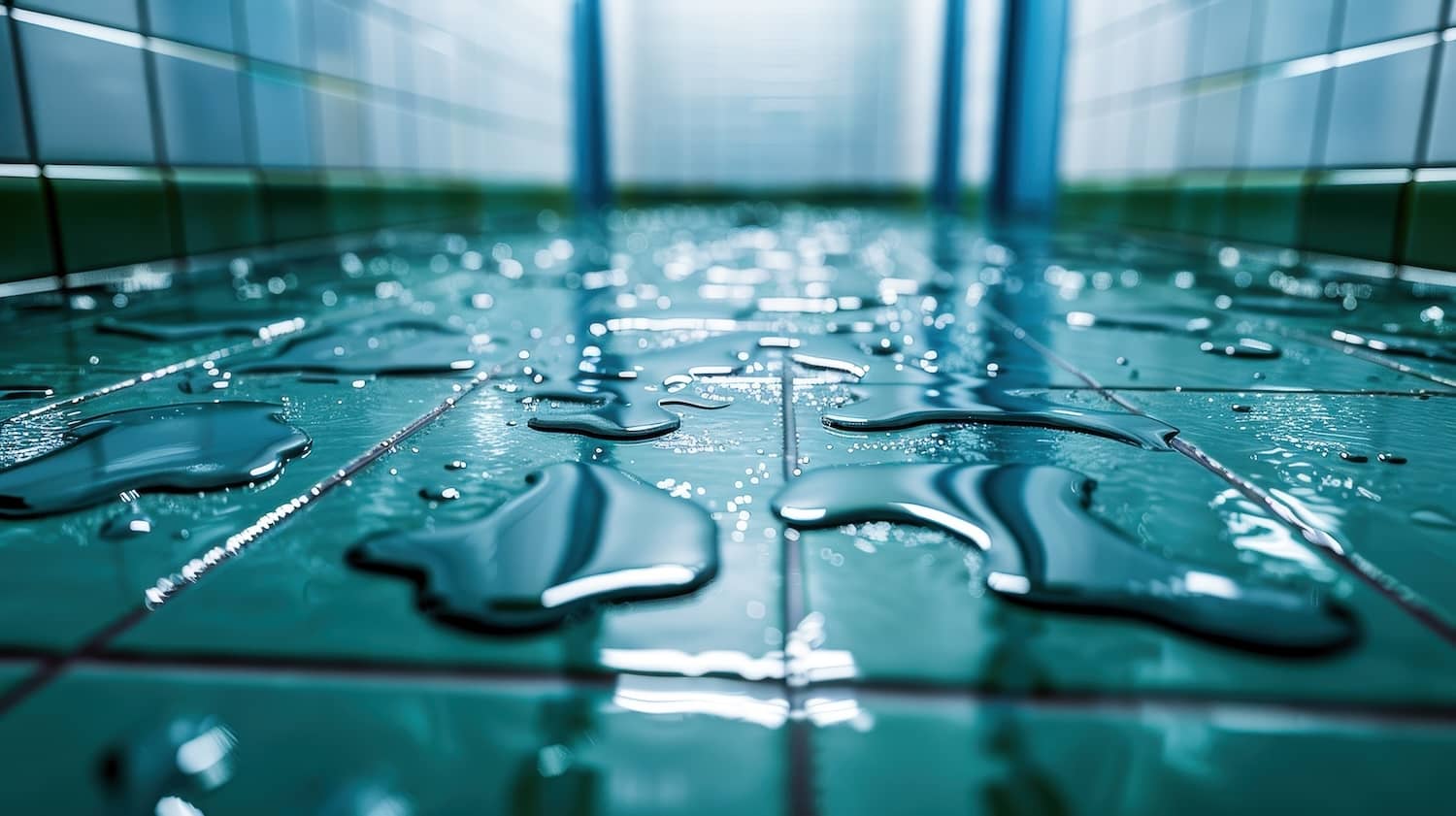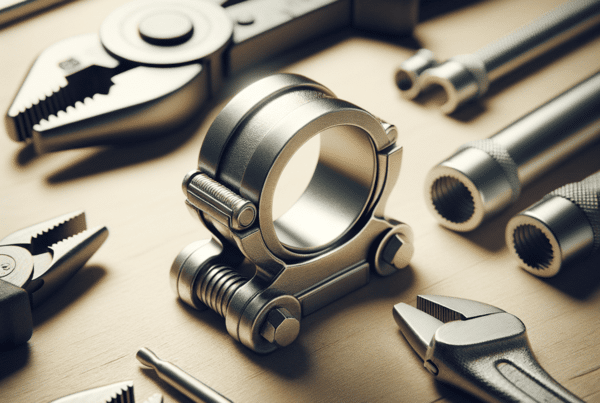
Few things are as frustrating as stepping into your shower to find water stubbornly pooling around your feet from earlier. Not only is it uncomfortable, but it can also lead to bigger headaches like mold, mildew, and even costly water damage.
If you’ve had enough of this pesky problem, you’re in the right place. We’re about to dive into three smart, simple tips that will help you keep your shower floor dry and your worries at bay.
Tip 1) Keep Your Drain Clear
One of the most common reasons for water pooling in your shower is a clogged drain. Over time, hair, soap scum, and other debris can build up, causing water to back up and pool on the shower floor. Keeping your drain clear and functioning properly is crucial to prevent this!
- Use a drain cover or hair catcher: This simple tool traps larger particles before they go down the drain.
- Clean the drain weekly: Remove any trapped debris and clean the drain using a natural solution like baking soda and vinegar. Consider it part of your regular cleaning routine. Just a few minutes each week can save you from the hassle of a backed-up shower.
- Address slow drainage immediately: If you notice water draining slowly, use a plunger to clear the blockage before it becomes a bigger problem. In more severe cases, you may need to use a drain snake or, if the issue persists, call a professional plumber. Persistent slow drainage could signal a more serious underlying issue. As a blockage deeper in your plumbing system or even tree roots infiltrating your pipes could develop over time.

Tip 2) Your Shower Slope
The slope of your shower floor plays a crucial role in how well water drains. If the slope isn’t angled correctly, water will have a hard time making its way to the drain, leading to pooling. The good news is that you can check the slope yourself with a simple DIY test.
Here’s how to do it:
1) Pour a small amount of water on the shower floor: Observe how the water moves. Ideally, it should flow directly towards the drain without any assistance. If the water lingers or pools, it’s a sign that the slope may be off.
2) Assess the results: If the water pools or moves slowly, there may be an issue with the slope. This could be due to a poor installation job or natural settling of your home over time, which can shift the floor’s alignment.
3) Consider your options: Minor slope issues can sometimes be fixed with a small re-tiling job or by adding a thin layer of mortar to adjust the angle. However, if the slope is significantly off, it’s best to consult with a professional who can recommend the best course of action. In some cases, a full re-tiling or even a complete shower floor replacement might be necessary, but the investment is worth it to prevent ongoing water issues.
Proper slope is critical not just for preventing water pooling, but also for ensuring that your shower drains efficiently and reducing the risk of leaks or damage.
Tip 3) Water-Tight Barrier
A properly installed shower door, curtain, or splash guard is essential for keeping water contained within the shower area. Without an effective barrier, water can easily escape, leading to pooling on the shower floor or, worse, damaging the surrounding areas.
Shower doors
Frameless glass doors are a popular choice for their sleek look and effective water containment. These doors provide a tight seal that prevents water from escaping, but they must be installed correctly to function as intended.
Poor installation can result in gaps that allow water to leak out, leading to the very pooling you’re trying to avoid. Additionally, consider maintenance—frameless doors often require regular cleaning to prevent water spots and soap scum from building up.
Shower curtains
Opt for a curtain with a weighted bottom or use a curved shower rod to keep the curtain in place and prevent water from escaping. A properly installed curtain should hang inside the tub or shower base, creating a barrier that directs water back into the shower area. For extra protection, consider using a liner that adds an additional layer of water resistance.
Splash guards
These are useful additions, especially for open shower designs, and help direct water back into the shower area. Splash guards are typically made of clear acrylic or glass and can be installed alongside shower doors or used in conjunction with curtains for added protection. They’re particularly effective in preventing water from splashing onto the floor when the shower is in use.

Other Maintenance Tips
Over time, the seals around the shower area, especially where the walls meet the floor and where the door or curtain is installed, can wear down. Reapplying caulk or sealant as needed can prevent leaks and water damage. Choose a high-quality, mold-resistant sealant for the best results and apply it carefully, ensuring a smooth, even layer.
Look for signs of wear or leaks in your shower fixtures. Even a small drip can add up over time, leading to excess water in places you don’t want it. Regularly tightening loose fixtures or replacing worn washers can help prevent leaks. Also, consider upgrading older fixtures to more water-efficient models.
Proper ventilation is essential for preventing moisture buildup, which can contribute to water pooling and the growth of mold and mildew. Make sure your bathroom fan is functioning properly and consider leaving the door or window open after showering to allow moisture to escape. Installing a timer on your bathroom fan can help ensure it runs long enough.
When to Call a Professional
Even with diligent maintenance, there are times when water pooling in your shower persists, signaling a deeper issue. If you’ve tried the tips outlined above and still find yourself dealing with standing water, it might be time to bring in a professional. Persistent pooling can be a symptom of underlying problems such as improper installation, significant slope issues, or deeper blockages within your plumbing system.
A professional plumber or contractor can assess your shower and diagnose the root cause of the problem. They have the expertise to identify issues that might not be immediately visible, such as structural damage or complex plumbing concerns that require specialized tools and knowledge to fix. Whether it’s correcting the slope, addressing a severe blockage, or upgrading your shower’s drainage system, a professional can offer long-term solutions that go beyond temporary fixes.
Finally, consulting an expert helps avoid potential water damage to your home’s structure and ensures your shower functions properly for years to come.
Conclusion
Keeping the shower floor dry doesn’t have to be a constant battle. These three smart tips can help prevent water from pooling and create a more comfortable, worry-free shower experience. When you show it some love, your shower and drain will remain safe, dry, and ready for use.
In NH, MA, and ME, call Alpha Building Inspections today to schedule professional inspections and guidance.



